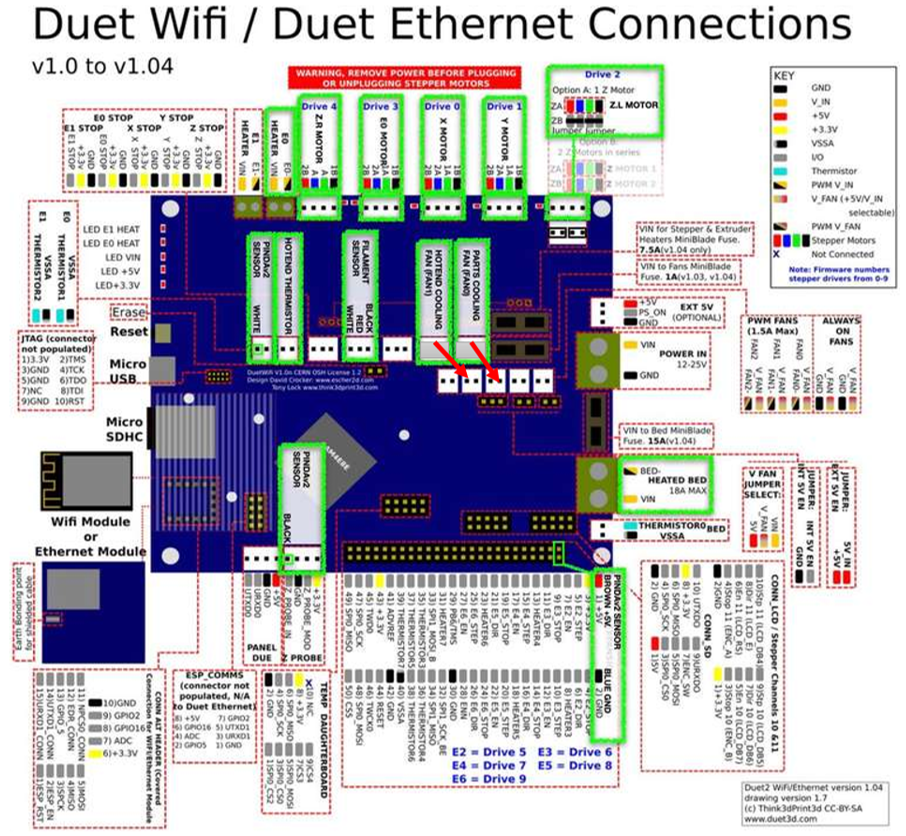PINDA V2 thermistor configuration
-
Thank your for the explanation!
That makes a lost sense then. I must have missed that in the documentation.I think I read somewhere that you can only chose between specific ports on Duet 3 for the Z probe but only the Z probe input for the probe on the Duet 2, but I might be wrong with that.
-
Were you using the Prusa Pinda V2 probe? Did it work with the temperature compensation? Can you share the wiring and the GCode used to set it up? Thanks
-
I've upped my Config. You can copy the things you need.
https://www.file-upload.net/download-14164086/Config.zip.htmlIf you intent to use the whole config: You will need to add this in your start gcode in your slicer software for the filament runout sensor:
; Prime Filament Sensor for Runout M581 P1 T2 S-1 R0 ; Filament Sensor P1 triggers Trigger2.g always (R0) TRIGGER OFF M950 J1 C"nil" ; Input 1 e0 Filament Sensor M591 D0 P2 C"e0stop" S1 ; Filament Runout SensorThe reason for this is that I wrote a filament autoload script and you can't have runout detection and autoload enabled at the same time without conditional code.
For the PINDA:
Black is the signal for the probe and goes into Z Probe in.
I connected 5V and GRND to the expansion port pins.
Thermistor is connected to E1You can read out the PINDA thermistor temperature but we'll have to wait for conditional code being implemented as the temperature compensation feature as it is right now assumes that the inaccuracy is linear.
-
Argo,
Thanks much for that! Which board are you using with this config?
All the best!
-
@Kolbi said in PINDA V2 thermistor configuration:
Argo,
Thanks much for that! Which board are you using with this config?
Configuration file for Duet WiFi (firmware version 1.21)
I saw different bin files for Duet3 and Maestro in the archive and it threw me off

-
Sorry the comment section is a bit old in my config ^^
RRF 3.11 and Duet WiFi
-
@Argo No sorrys needed - you definitely got me way further along with my setup!
-
@Argo Thanks for the info. I have PINDA v2 on order so this will help me once I get it installed.
-
Argo,
Looking at your config and postings I believe the attached graphic, WITH EXCEPTION OF FANS, depicts your wiring configuration - can you confirm please?
I Drew this up before work, flubbed the fan locations - they have to go one row down and move to the 2nd and 3rd connector on the board, corresponding to FAN1(2nd) and FAN0(3rd). I'll correct this after work.Thanks much

-
E0 endstop (filament sensor) is the 1st in the row not the second.

-
@Argo Ah... When looking at the top-left endstop block, I read it as E1-E0-EX-EY-EZ?

So do you have the filament sensor plugged into the first endstop?
-
Good you have a photo of it unplugged. Seeing through all the cables of my board I thought it’s the first one I connected.
So yes you are right it’s the second for E0. -
The corrected wiring overview.

I'm working on a step-by-step guide, once done I'll post it.
V/R,
Kolbi -
I installed the Duet wifi on my Prusa MK3s this past weekend, no issues at. She got the Zaribo 10mm full upgrade as well as Duet wifi so it's really a completely different machine.
For firmware settings, I used @Argo configurations - here
For wiring, I used a guide I created, and now verified - here
Cheers,
Kolbi -
I did just switch the case fan from constant power to fan2 and followed the guide here: https://duet3d.dozuki.com/Wiki/Mounting_and_cooling_the_board#Section_Cooling
M308 S2 Y"drivers" A"DRIVERS" ; configure sensor 2 as temperature warning and overheat flags on the TMC2660 on Duet M308 S3 Y"mcu-temp" A"MCU" ; configure sensor 3 as thermistor on pin e1temp for left stepper M950 F2 C"fan2" Q100 ; create fan 2 on pin fan2 and set its frequency M106 P2 H2:3 L0.15 X1 B0.3 T40:70 ; set fan 2 value""""Creates sensors for the driver overtemp flag and the MCU temp reading using M308 as S2 and S3. Creates a fan port for Fan2 with M950. Then creates a fan command to link those sensors to fan2 with a temp range of 4code_text0-70 using M106.""""
*This made the case fan MUCH quieter and with that it only runs when its needed.